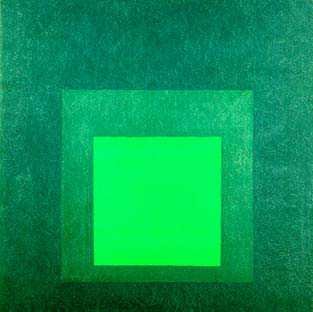Josef Albers and Laszlo Moholy-Nagy
dal 1/11/2006 al 20/1/2007
Segnalato da
1/11/2006
Josef Albers and Laszlo Moholy-Nagy
Whitney Museum of American Art, New York
From the Bauhaus to the New World. An exhibition dedicated to two of the greatest pioneers of Modernism in the 20th century. This exhibition, spanning four decades and comprising more than 170 works, focuses on their individual accomplishments as well as the dialogue between their works and examines their groundbreaking moves towards abstraction in the early 1920s. On show a range of media, including painting, sculpture, photography, film, and furniture design.

From the Bauhaus to the New World
Josef Albers and La'szlo' Moholy-Nagy were two of the greatest pioneers of Modernism in the 20th
century. This exhibition, spanning four decades and comprising more than 170 works, focuses on
their individual accomplishments as well as the dialogue between their works and examines their
groundbreaking moves towards abstraction in the early 1920s. Albers and Moholy-Nagy: From the
Bauhaus to the New World, organized by Tate Modern, will be on view at the Whitney Museum of
American Art from November 2, 2006, to January 21, 2007.
Though the paths of German-born Josef Albers (1888-1976) and Hungarian-born La'szlo' Moholy-
Nagy (1895-1946) only overlapped for five years, between 1923 and 1928 when both were
teaching at the Bauhaus, their artistic practice was informed by similar concerns, including an
emphasis on experimentation, the subversion of traditional boundaries between media, high and
applied art, and a probing into the status of the work of art in an age of mass production.
Offering a range of media, including painting, sculpture, photography, film, and furniture design,
this show highlights Albers's eye-catching glass constructions from the 1920s and early 1930s,
examples of his largely unknown photographic work, his machine engravings and a group of his
early Homage to the Square paintings. It also features a wide selection of Moholy-Nagy's
innovative photographs, including his “camera-less" photograms and photomontages, his rarely
exhibited forays into color photography, his film works, and his experiments with aluminum as well
as with novel synthetic materials such as Perspex and Rhodoid.
Moholy-Nagy's Light Prop for an Electric Stage (1930) was reconstructed especially for the
exhibition. Dramatically lit, this kinetic work comprises several rotating elements that cast lights
and shadows on the surrounding walls. It is being exhibited more than seventy-five years after the
original was first displayed at the Grand Palais, in 1930, and is arguably one of the earliest
examples of installation art. Light Play: Black-White-Grey (1930), a five-and-a-half-minute silent
film will also be shown; it records the play of light on the Light Prop.
This exhibition takes as its starting point the years following the First World War, when Albers and
Moholy-Nagy independently abandoned representation in favor of a rigorously abstract language.
It then follows their work through the 1920s with a particular focus on their involvement with the
Bauhaus, Weimar Germany's hothouse for Modernist art and design education. For both artists this
time was marked by technical innovation, with Albers adopting industrial processes such as
sandblasting to create an extraordinary series of flashed glass works, and Moholy-Nagy exploring
new synthetic materials, such as Perspex, as well as experimenting with photography and film.
The second part of the exhibition is dedicated to the work Albers and Moholy-Nagy produced
following their emigration to the US, when Albers took up teaching posts first at Black Mountain
College and then at Yale University, and Moholy-Nagy set to revive the Bauhaus with the shortlived
New Bauhaus in Chicago before founding his own school, The School of Design in Chicago
(subsequently The Institute of Design). Their work from the 1930s and 1940s reveals how both
men built on earlier experiences while ceaselessly pushing the boundaries of their artistic practice.
Albers and Moholy-Nagy: From the Bauhaus to the New World was curated by Tate Curator Achim
Borchardt-Hume. The New York installation is organized by Carter Foster, the Whitney’s Curator of
Drawings.
It is accompanied by an illustrated catalogue which contains essays by Hal Foster, Achim
Borchardt-Hume, Nicholas Fox Weber, Hattula Moholy-Nagy, Terence A Senter, and Michael White.
Before coming to the Whitney, the exhibition traveled to the Kunsthalle Bielefeld, Germany.
About the Whitney
The Whitney Museum of American Art is the leading advocate of 20th- and 21st-century American
art. Founded in 1930, the Museum is regarded as the preeminent collection of American art and
includes major works and materials from the estate of Edward Hopper, the largest public collection
of works by Alexander Calder, Louise Nevelson, and Lucas Samaras, as well as significant works by
Jasper Johns, Donald Judd, Agnes Martin, Bruce Nauman, Georgia O'Keeffe, Claes Oldenburg, Kiki
Smith, and Andy Warhol, among other artists. With its history of exhibiting the most promising and
influential American artists and provoking intense debate, the Whitney's signature show, the
Biennial, has become the most important survey of the state of contemporary art in America today.
Opening: November, 2, 2006
Whitney Museum
945 Madison Avenue 75th Street - New York
Hours: Wednesday, Thursday, Saturday, and Sunday from 11 a.m. to 6 p.m., Friday from 1 p.m. to 9 p.m., closed Monday and Tuesday.



